|
From HORSEMAN Magazine, June 1968

by Bob Gray, Editor
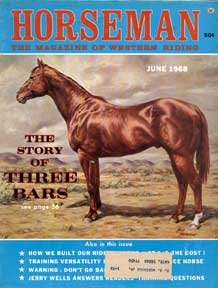
PERSONAL STORY FROM A RELATIVE OF SID & MAYOLA
VAIL
The
"Cinderella Horse," they called this
Thoroughbred stud,
and there is no question but what he very nearly
remade the
Quarter Horse business.
At 4:45 on the morning of April 6, 1968, a
living legend of the horse world
breathed his last at
Sayre, Oklahoma. Three Bars was two days shy of
being twenty-eight years old when he died from a
heart attack.
He was on his feet until fifteen minutes
before he died. He was used for breeding
purposes until two days before his life ended.
In terms of a long, useful life—and in terms of
his value—few horses in the western horse field
can be compared to Three Bars. In terms of his
impact on the Quarter Horse breed, there is
little comparison. It is simply monumental.
Imperceptibly at first, then at dead run,
Three Bars breeding refashioned the yardsticks
by which the Quarter Horse world measured short
racing and good conformation. Three Bars proved
that a race horse could be an outstanding
conformation horse. Largely through the
influence of this one horse, the Quarter Horse
world today is breeding a taller, faster, more
streamlined animal. As King P-234 set the
standard for the stock horse in the 1940s, so
did Three Bars—in company with Top Deck and
Depth Charge—change the concepts of the 1960s.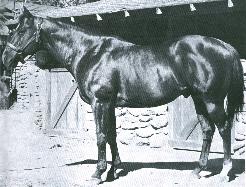
This photograph of Three Bars, taken in 1954 at
Dart Ranch Stables, Tucson, Arizona, shows his
conformation. And although he stood just over
15.1, he was considered small by Thoroughbred
standards -- that size, coupled with his other
conformation assets, was transmitted to a
remarkable number of Quarter Horse mares. The
hindquarter muscling is particularly noteworthy
in that it approaches the idea sought by stock
horse men. When this photo was taken, Three Bars
was fourteen years old. The irregular patterns
on his knees and ankles are probably from the
'firing' that was done earlier to strengthen his
legs.
Statistics may be dry but in Three Bars' case
they are meaningful. In Quarter Horse racing, he
was the all-time leading Sire of Register of
Merit Qualifiers through 1967, as well as
Leading Sire of AAA Quarter Horses. He also was
Leading Sire of Money Earners. Official records
at the American Quarter Horse Association at the
time of his death show that Three Bars sired 384
offspring earned more than $2.8 million in 7,824
races through 1967. In the show ring, Three Bars
descendants earned 259 working points, 1.283
halter points, twenty-three AQHA Championships.
Equally significant is the fact that, through
April, 1968, all three of the newly crowned
Supreme Champions—Kid Meyers, Bar Money and
Fairbars—were get of Three Bars.
Great as he was, the Three Bars story is also a story
of people and their love for a really good
horse. It may be said to have started where so
many great horse stories began, in Kentucky. It
started well before the Quarter Horse existed as
a breed.
Jack Goode of Paris, Kentucky, began his
lifelong love affair with racehorses as a boy.
Growing up in racing country, he watched them
every chance he got. One speedy filly he never
forgot was Myrtle Dee. A daughter of Luke McLuke,
she was a Thoroughbred sprinter of such
excellence that she held the 5 1/2-furlong
record for many years at the Coney Island track
in Cincinnati.
So it was that in 1939, Jack—now
grown—heard that Myrtle Dee was going to be sold
at public auction. Horses belonging to Jack
Parrish at Midway, Kentucky, were being
dispersed. Jack and two friends, Ned Brent and
Bill Talbot, negotiated for and finally bought
old Myrtle and two other mares in an $800
package deal, prior to the sale. She was then in
foal to Parrish stud, Percentage. That horse had
the reputation of being both a sprinter and a
distance racer.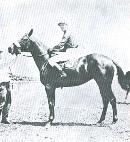
This is Myrtle Dee in
her racing days of the 1920s. She was a sprinter
and her short distance excellence earned the
admiration of all who
saw her --including the man (Jack Goode) who
would later buy her in
foal to Percentage. She held the 5 1/2 furlong
track record at the
old Coney Island track in Cincinnati.
Myrtle Dee
went out to pasture on Brent's Farm in Bourbon
County, Kentucky. Returning from the Keeneland
track one April day in 1940, the owners spotted
a fine looking stud colt nursing Myrtle. They
each admired the youngster, foaled April 8. No
question about it. The old mare had produced a
good one. Recalled Goode: "...We all said that
we had hit the jackpot. So we named him Three
Bars. You know when you hit the jackpot [on a
slot machine] how three bars come up? That's how
he got his name..."
It did indeed seem that the trio of owners
had a jackpot. This had to be a sprinter -- as
Goode confirmed to his own satisfaction when he
broke and trained the colt the following year.
Ned Brent remembers that Three Bars ran the
quarter mile in 21 and a fraction. He had a
tremendous surge of power over the short
distance, broke like a bullet and his owners
began to dream of the future.
"Then," recalls, Goode, "in the spring of
his two-year-old year I was bringing him off the
track one morning when it happened. His hind leg
turned ice cold, just like you had suddenly
turned off the blood. He never got over it while
we owned him..."
"Until that happened he was the fastest
thing I had put a bridle on. He was too rapid.
You had to ease him to slow or he'd get out of
hand and you couldn't handle him well. I took
him to Keeneland at Lexington and to Detroit but
never raced him because his leg would get cold
when he exerted himself. We had some of the best
vets in Kentucky with Three Bars but they
couldn't help that leg." |
|
Fog and mist
rolled in over the race track at Detroit's 1944
meeting as Stan Snedigar watched the early
morning workouts. His racing savvy would become
legendary in the business and Stan peered
intently at every young prospect the exercise
boys ponied by. One colt in particular caught
Snedigar's eye -- a chestnut colt, small by
Thoroughbred measurement. Nearby, Stan spotted
Frankie Childs, one of the most noted trainers
of the time."Frankie," he asked, "who is this
little chestnut horse going by?"
"That little horse is called Three Bars,"
said Childs.
"Know anything about him?"
"Know all about him."
"Tell me something about him."
"He's as fast a horse as I ever saw. We
broke yearlings at Keeneland...this horse was in
the group of yearlings being broke that year. We
gauged all of the yearlings by what they might
do with this horse Three Bars, out of the
gate..."
"What kind of races is he running in?"
"I think they're running him in $2,000 and
$2,500 claiming races," replied Childs.
Snedigar also learned that the owner of the
horse was a friend of his, Eudell Wyatt,
considered one of the good harness and show
horse trainers of the country. When Stan learned
later that Three Bars had won his next race at
Detroit, he sought out Wyatt.
"Now, Brother Wyatt," allowed Snedigar,
"I'm gonna claim that horse if you ever run him
again for $2,000. What will you take for him?"
"I don't want to sell him," Wyatt replied.
"What do you want with him?"
"I'd like to take him to Arizona with me
and cross him with some of those little Quarter
mares we have back in that country and use him
as a sire."
"Well," said Wyatt, "he might cross alright
with them. He sure has speed."
"Yes, and I like his conformation."
However, this Three Bars Admiration Society
did not produce a horse trade. When Snedigar
left for Phoenix he did not own the
horse—although he still wanted to. He told his
trainer, Cal Kennedy, to claim the horse for up
to $6,000, if he turned up in another claiming
race.
"I had been home probably a week when the
phone rang one night and it was Kennedy. He
said, 'We've got a new horse in our barn
tonight.'"
Sure enough, Three Bars had won by about
six lengths in a six furlong race and Snedigar
and his partner, Toad Haggard, owned him. The
claiming price: $2,000. They had their horse
shipped to Albuquerque for the meet there and it
was on New Mexico turf that Three Bars won again
as a four-year-old. The distance was
three-eighths of a mile. Next, they moved on to
Santa Anita where, in late 1944, came a major
disappointment. The war "blacked out" racing for
the duration.
"Here we were," Snedigar recalled many
years later, "in Santa Anita with a string of
horses ready to run. And we had some that
weren't the soundest in the world, so we fired
two or three horses, among them Three Bars. We
fired his knees and ankles and brought him back
to Phoenix."
Snedigar and Haggard, in both the cattle
and horse business together, planned to winter
there and turn out their horses because of the
racing shutdown. Haggard also had decided at
this point to plan on dispersing his interest in
the horses—and that decision roughly coincided
with the appearance on the scene of the next key
person involved in the Three Bars story.
Sid Vail got his horse sense and savvy at
an early age in what is usually called the
School of Experience. His birth certificate
shows he was born in Aberdeen, Mississippi,
November 13, 1913.
"We were farmers in Mississippi," he
remembers. "I ran away from home when I was 14,
headed west to Texas, New Mexico, Arizona. When
I was 16 I started riding rodeo bulls and
bareback horses. Then I broke horses in Montana.
In 1923 I packed for the government through
Yellowstone Park. They were mapping the park and
I packed horses and gear up and down those
mountains...it was beautiful.
"Well, when I was going up and down those
mountains with those old horses, I used to dream
a lot about a real good horse. Then in 1939, I
bought a Quarter Horse. I was in Nevada then.."
Since the Quarter Horse registry was not
formed until 1940, the term "Quarter" horse in
the thirties did not mean exactly what it means
today. Then, you were talking strictly
about a race-type animal. Westerners loved their
"short" races then as now. The competition in
Arizona was particularly keen over the short
distances. When Vail, within a few years, heard
about Three Bars,
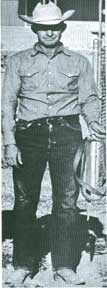 he
was interested. He was then living in Douglas,
Arizona. he
was interested. He was then living in Douglas,
Arizona.
"I heard there was a good Thoroughbred they
were breeding to Quarter mares," he recalled. "I
had some Bear Hug mares so I went down to see
them about it. When I saw the horse, I knew I
had to have him. I had never seen anything like
him. And I've never seen anything like him
since, either.
"Stan [Snedigar] said the horse wasn't for
sale after I'd offered $5,000..." In the
bargaining process that followed, which took
some time, Three Bars did finally change hands.
But it was with the utmost reluctance that
Snedigar finally agreed with his partner to sell
Vail the horse for $10,000. And Snedigar said he
insisted on the stipulation that if Three Bars'
legs proved sound a year later, he would have
the opportunity to race him some more.
This is what happened, as it turned out.
Three Bars did race with some success in
1946, winning eight of seventeen starts for a
total of $16,940.
Sid Vail, the
cowboy who made Three Bars
the Cinderella
Horse of the 20th Century.
Two decades later, Snedigar could recall clearly
what made him like the horse so well:
"I liked his ability to run right out of
the starting gate. He had the conformation to do
this and he had the ability to run. Even though
his legs weren't the soundest—they were crippled
at the time and he was very sore-kneed—this
horse had the will to come out of the starting
gate almost always in front and run just as far
as he could, as fast as he could. He was a horse
you couldn't rate. You could steady him but you
couldn't rate him. You couldn't take hold of him
and take him back because he'd get mad and
wouldn't run.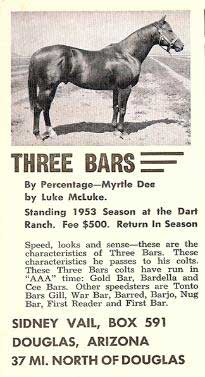
"With this will to want to win every race,
his ability to go ahead and perform according to
the way his conformation looked, made me
think he'd be a great Quarter Horse sire. And he
turned out to be just that."
Although it appears that mares were bred to
Three Bars earlier, his
first real test in the stud came the year Sid
Vail purchased him.
"We stood him in 1945 and 1948 at Melville
Haskell's place at Tucson, Arizona...then in
'49 and '50 I stood him at John Chaney's place
near Tucson. I'd go over and get the horse to
breed to my own mares. Then I stood him at
Douglas in 1951. In 1952 Walter Merrick took him
to Crawford, Oklahoma, where he stood at $300
stud fees. The stud fees went up something like
this: $100 in 1945, about $250 in 1948. Then it
went to $300...
"After that, it jumped to $500, then to
$1,000, next it ws $1,500, then $2,500, then
$3,500, then $5,000. From 1963 to 1966 it was
$10,000, which is the amount I paid for Three
Bars back in 1945. Then in 1966 in the fall,
Walter took him to Quanah and stood him for
$5,000. That's what his fee was when he died at
Sayre, Oklahoma."
"During those years, the mares that came to
Three Bars not only represented good business
but the cream of the Quarter Horse crop. To
mention a few of these great mothers would be a
slight to the hundreds that began, by the 1950s,
to make regular annual trek to Vail's Three Bars
Ranch at Oakdale, California. It might be called
the House That Three Bars Built and it was a
first class operation. Sid and his wife, Mayola,
watched for twenty years as a constant stream of
admiring breeders pulled up and unloaded their
prize mares, season after season. Not many lads
who start punching cows for $40 a month wind up
in quite the same position Sid Vail found
himself occupying by the mid-1960s. You don't
have to be an Einstein to figure out how much
money you're handling with a stallion whose stud
fee is $10,000—and you're turning business away.
Not surprisingly, third and fourth generation
Three Bars
descendants were soon found topping the auction
sales in price, starting to steal the thunder in
the halter classes, carrying the calf ropers to
the pay window—and dominating the big money
Quarter Horse race meets. One one fantastic day
at Sacramento, in the running of the 1965
Pacific Coast Quarter Horse Futurity, the first
five horses under the wire were all grandsons
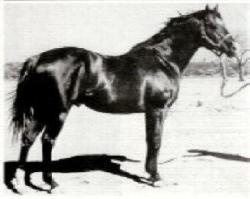 of
Three Bars. of
Three Bars.
Three times in his life, the horse very
nearly met a premature end —once by theft, twice
by illness. It was along about 1957, Vail
recalls, when someone actually stole Three Bars.
"They came in sometime during the night and
took him off. Took
him down the road a mile or so and bred a couple
of mares. But
they had some trouble with him, I think. Anyway,
they hit him in the
face with something. They'd jerked the halter
right off of him...he
came home on his own. I found him trying to
fight off another stud through a fence. There
was blood all over Three Bars and the fence,
too. But it was by being hit in the
nostrils...it made his nose awful sensitive
after that and boogered him up a little.
"So," continued Vail, "I put a lock on his
door for a couple of years...and figured nobody
would steal him anymore. Nobody did...but it
left his nose very sensitive where they'd hit
him. Every time you put a halter on him he
wanted to rub his nose on you or a post or wall
or something.
"Then in 1962 or 1963 both he got sheep
virus. The vet gave him a fifty percent chance
of living on both occasions. We almost lost
him both times."
Three Bars was ridden and exercised under a
stock saddle like any other western
horse—particularly during breeding season—until
about 1962, according to Vail.
"Yes, he was easy to handle but Three Bars
was full of fire. He was one of the nicest
horses you'd want to have around. But he didn't
like to be brushed or have his feet trimmed.
He'd show a lot of white in his eye. If you
didn't know him, you'd think he was thinking
about eating you up.
"Sometimes he would make a dive at you, but
he wouldn't hurt you. Like I say, Three Bars had
a lot of fire to him. Guess that's what made him
live so long. I was with the horse for
twenty-three years. Owned him all the time until
his death. Twenty-three years with the same
horse is a long time. I was over at Walter's
[Walter Merrick] a few months before he died and
they were going to breed him...Anyway, I finally
walked off because his knees looked so bad I
couldn't stand it. I remember him as a young
horse and I've watched him get old..."
Like many noted stallions, Three Bars had
his attachments too. One was a mare named Fairy
Adams. If it can be possible for a stallion to
be in love, Three Bars had this feeling for this
mare, by all accounts.
Vail first brought the mare from Jay Frost
in 1962. She was blind, he recalled, and was
kept in a paddock next to Three Bars in
California.
"They became very attached to one another.
Three Bars would get excited and upset when she
wasn't in the paddock. They just sort of fell
for one another. So when Walter came to take
Three Bars to Texas I just gave him the mare...I
had never seen Three Bars lie down in all the
time I had him. But after Walter put Fairy Adams
in the stall next to Three Bars, he'd lie down
and rest...she was good for him."
Added Merrick: "Whenever we took Three Bars
out to exercise, we had to take Fairy Adams or
he'd get excited and start fussing. If she
wasn't in the stall next to him, he'd start
nickering and walking the stall and get
uneasy..."
At the time of his death, Fairy Adams was
thought to be in foal to Three Bars, was nursing
one of his colts, and her yearling filly by
Three Bars was not far away. She was also one of
the last mares bred to him before he died.
Photos of what some called the "Cinderella
Horse" show that Three Bars, in terms of
conformation, was himself very close to the kind
of animal many western horse breeders have been
working toward. He stood fifteen hands, one and
three-quarters inches in height and, by Sid
Vail's estimate, weighed from 1,160 to 1,25,
depending upon the time of year. Stan Snedigar
recalls that Three Bars as a young stallion,
weighed perhaps 1.050 pounds in racing
condition.
However, the key to Three Bars' greatness
came not merely from his physical appearance nor
his speed on the track. It came rather from that
special and elusive magic breeders call
prepotency. It was his magic—this ability to
gather the best that was in him and plant those
qualities in his offspring—that made Three Bars
the architect of the modern Quarter Horse. |
